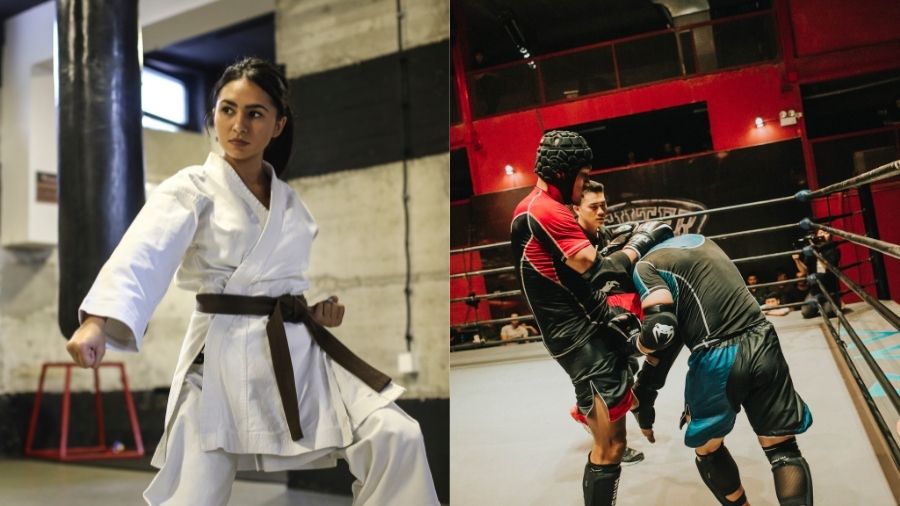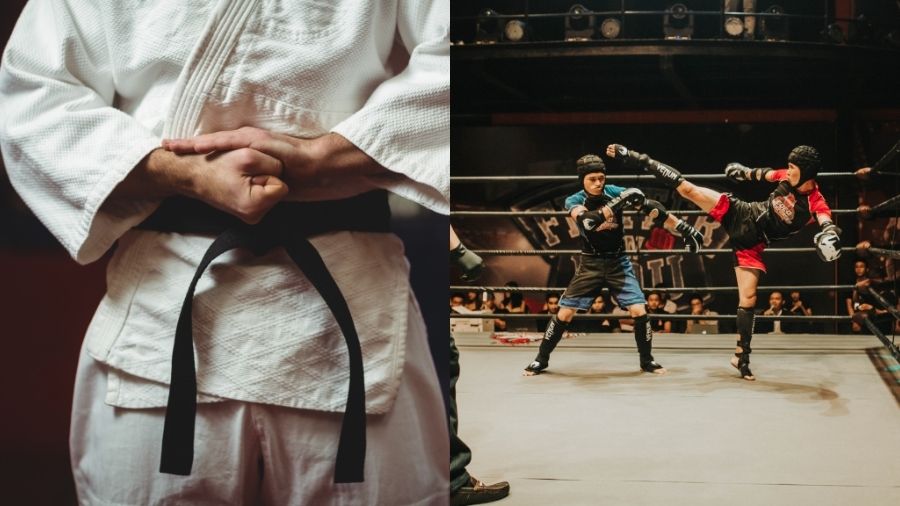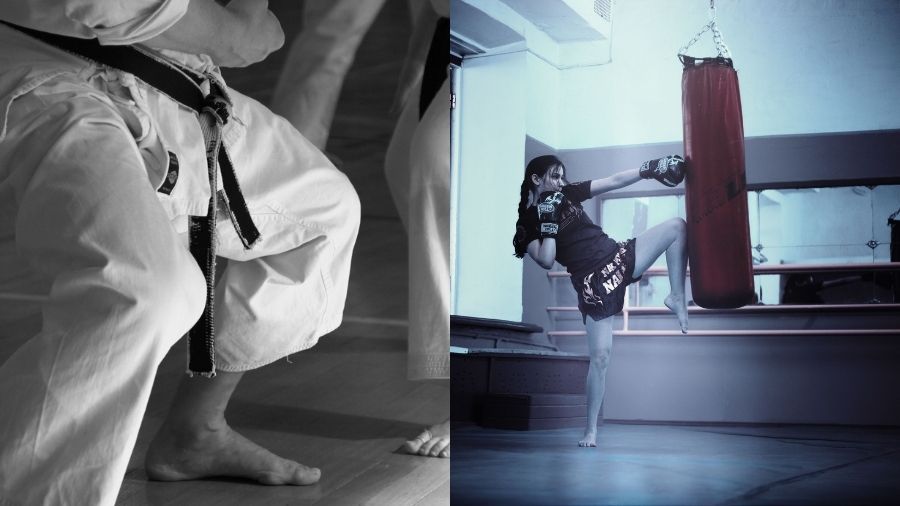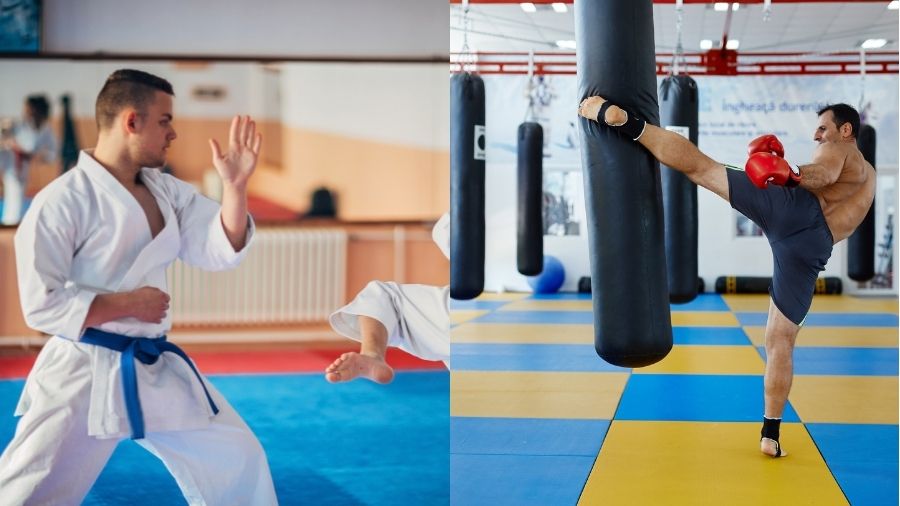Karate and Kickboxing are the two most popular martial arts when it comes to striking. Both are well spread in all parts of the world, and on paper, they share a lot in common. But if we set them apart, which one is better and why?
Karate is a striking art that has many forms and styles. Most focus on using all limbs as weapons to strike, emphasizing speed and technique. Kickboxing has origins in Karate and Muay Thai and is all about power and damage. It looks similar to Karate on paper but differs a lot regarding rules, emphasis, and many other aspects.
Keep reading this article to learn more about Karate vs. Kickboxing. We will explain all the differences and see how these two compare in various aspects.
What Is Karate?
Karate is, perhaps, the most famous martial art that comes from Japan. It has many styles and forms, out of which most focus on using all limbs as weapons to strike with kicks and punches. Some forms also include elbow and knee strikes and throws, trips, and dirty tactics. The modern form is all about striking, and some of the most popular styles are:
- Shotokan
- Goru Ryu
- Kyokushin
Karate doesn’t differ a lot from other arts that mix punches and kicks on paper. But bear in mind that the emphasis is on light contact, speed, precision, and footwork. There is no hard sparring or throwing direct power shots in most forms and styles. It’s a traditional art where the ultimate goal is to overcome oneself through martial arts training.
Discover The Little Known Secrets For Unlocking Devastating KO Power!
Heavy hands are built doing these things...
In modern days, competition plays a significant role, and students spend most of their time learning how to fight under the rules.
What Is Kickboxing?
The term kickboxing is a bit confusing since it has two meanings. First of all, it stands for all martial arts that mix punches and kicks together like Sanda, Muay Thai, and even Karate. And second, it is a combat sport created in the 1950s as a mix of karate techniques and Muay Thai full contact rules.
As its name suggests, “Kickboxing” is a mix of versatile kicks and western boxing techniques. It is a full-contact style where the emphasis is on throwing each strike with a lot of power and intention to knock the opponent out cold. It doesn’t contain any light contact or point fighting rules, but instead, it is the total opposite.
Yes, it consists of Karate techniques but differs a lot in the way you execute those moves and rules. In modern Kickboxing, there are a couple of different styles/rules:
- K-1
- Dutch Style
- American Kickboxing
- Japanese Kickboxing
What Are The Differences Between Karate And Kickboxing?

Kickboxing has origins in Karate, so these two arts share more than a few things. But on the other hand, these two are a world apart if you look at the emphasis, rules, and concept of training.
History And Origins
But the man who did this was Osamu Noguchi, a boxing promoter. He was the first to put together a set of rules, use the term “kickboxing,” and form the first “kickboxing association.”
Strategies And Emphasis
Karate is a striking art created for self-defense and real fighting. The emphasis is on fast striking, footwork, precision, and light contact. The main goal is not to throw strikes with much power but to beat the opponent with technique.
Students learn how to finish the fight without causing injuries. It is not an aggressive style where you have heavy sparring and people knocking each other in the gym. The main goal is to keep the mind calm, be strategic, and showcase a high level of technique.
Kickboxing is the total opposite in some way. Students learn how to throw each shot with a lot of power, cause injuries, and knock the opponent out cold. It is a more aggressive style with less footwork and moving around.
Techniques
Karate is a versatile martial art that teaches you how to use all limbs as weapons to strike. Traditional forms also teach the basics of grappling and even dirty moves. But there is a clear difference between what you learn in training and what you use in matches.
In classes, students learn how to strike with kicks, punches, elbows, knees, execute some throws, sweeps, and trips. But once they step on the mats to compete, they can use just a handful of techniques. There are no elbows, knees, trips, and throws.
Kickboxing techniques are pretty simple. Students learn how to mix karate kicks with punches from western boxing. They also learn to fight at close range and in the clinch using elbow and knee strikes from Muay Thai. It all revolves around five different punching techniques, a couple of kicks, and mixing these strikes together.
Rules
The “World Karate Federation” regulates the karate point scoring system. The goal is to win more points, not score knockouts or hurt the person in front. The emphasis is on light contact, timing, form, awareness, and precision.
Karate matches occur on an 8m x 8m matted square area called “Tatami.” Matches usually last 3 minutes and can also have 2 or 3 rounds.
- 3 points (Ippon) for a kick to the upper body
- 2 points (Wazari) for kicks to the mid-level
- 1 point (Yuko) for mid or upper-level punch
- In most styles, the action resets after every point
- Karateka can win a match by securing a lead of eight points or having more points when the time expires.
Kickboxing has different rules sets like K-1, semi contact, full contact, etc. For this article, we will explain famous K-1 rules that are most popular:
- Kickboxers compete inside the square ring
- Matches have from 3 to 5 rounds, with each round being 3 minutes long.
- Fighters can win a match via knockout or decision
- They can cause damage using kicks, punches, and knees.
- Fighting in the clinch is allowed for only 5 seconds and if the attack is productive.
Karate vs. Kickboxing For Self-Defense

Kickboxing is better than Karate when it comes to self-defense, and it is tough to argue against that. Yes, this may sound odd as Karate is a self-defense system while Kickboxing is a combat sport. But the only thing that matters on the streets is how practical techniques are. And in this case, the concept of Kickboxing is more effective.
The biggest downside of Karate has always been the lack of full contact. The main idea is to defend using speed, precision, and technique rather than full power. You must focus on keeping both parties safe and not cause injuries.
This sounds nice, but you need aggression in street fighting where you can lose your life in a split second. The last thing you need is to think about how much power you put into strikes.
Kickboxing is much better as the emphasis is on knocking the opponent out with every shot. It trains a person to strike with violent intention from all ranges, cause injuries and knock the opponent out.
Students spend a lot of time sparring hard in training, which is the only way to learn how to fight. You can’t expect to train your mind and body for real fighting without trading hard punches and kicks in sparring.
This concept transfers well into self-defense because you need to finish the fight as fast as possible on the streets. You never know if the attacker has any weapons, or maybe their friends may decide to jump in.
Karate vs. Kickboxing For MMA
The concept and rules of Kickboxing fit better in MMA. This doesn’t mean that Karate is bad for cage fighting.
What Karate brings to the table is excellent footwork, speed, angles, and hard kicks. These fighters are tough to hit, cut off, or defend against because of their unorthodox striking. They tend to bounce around in all directions, keep their hands low, attack in a blitz, and are masters in counterattacking. Some of the most famous fighters are:
- Robert Whittaker
- Stephen Thompson
- Lyoto Machida
The biggest downside of Kickboxing is the lack of footwork, as its fighters tend to stay flat-footed. And the other issue is the lack of advanced head movement. Some of the best Kickboxers in the game are:
- Israel Adesanya
- Edson Barboza
- Valentina Shevchenko
Karate vs. Kickboxing – Which Is Harder To Learn?

Karate takes more time to master, including a belt ranking system and strict promotional criteria. On average, students need around six months to 1 year to get good at all the basics. Next, they need to work hard for approximately 4 to 6 years to earn a black belt. You may do it in less time, but this depends on many factors like talent, dedication, or how passionate you are.
On the other hand, Kickboxing takes less time to get good at as it doesn’t include any ranks. Its techniques are simple and easy to learn to some extent. Even if you have never thrown a punch before, you won’t struggle with the basics.
Students need around 3 to 6 months to learn stances, punches, kicks, and combos before they start sparring. Then after approximately six months to 1 year, you may start thinking about taking part in amateur matches.
After 1 to 2 more years on the amateur level, you may start thinking about turning pro. So, in total, it takes around 3–4 years of kickboxing training to go from beginner to pro levels.
Overall, training in both of these arts includes similar techniques. But the concept and structure of training differ a lot. No matter which art you choose to train in, expect to work hard, leave it all on the mats every single time, and have a ton of fun.
Karate Pros And Cons Against Kickboxing
Karate is a versatile martial art with a couple of pros and cons compared to Kickboxing.
Pros
- Versatility — Karate is more versatile when it comes to weapons. Apart from punches and kicks, traditional forms teach you the basics of grappling. The number of techniques one needs to learn is also why Karate takes more time to master.
- Footwork — Karate is among the best arts when it comes to how to judge distance and keep your range. It will teach you all about footwork, how to move in and out fast, and attack from various angles. Kickboxers tend to stay flat-footed and keep their head in the centerline, which is not a good thing.
- Speed, timing, and precision — apart from power, speed and precision are vital striking elements. Due to point fighting rules, Karate is all about moving in fast, landing a strike, and getting out before being hit with a counter. Although it lacks power, landing a fast and precise strike is often enough to hurt the opponent.
Cons
- Lack of power — most Karate forms focus on light contact and being technical. This is a big downside for self-defense, MMA, or any type of freestyle fighting.
- Longer time to master — Karate comprises belt ranks and strict promotional criteria. Students also do a lot of katas, various breathing and meditation exercises, and the progress is really slow. Much slower than Kickboxing.
Kickboxing Pros And Cons Against Karate?

Pros
Self-defense and MMA — Kickboxing works better on the streets and cage fighting. Its emphasis on power is what would keep you safe on the streets. Whether we are talking about street fighting or matches in the ring, the final goal in Kickboxing is clear as day: finish the fight. Its concept works much better when the fists start flying in the bar, parking lot, or anywhere else.
Sparring — Students tend to spar a lot in Kickboxing classes. Perhaps this is the only way one can develop automatic reactions and timing and learn how to control distance. It also helps a person learn how to stay calm in a fight, assess the situation, and have a clear vision.
Simple and easy to learn — Of course, you need to spend years to master Kickboxing truly. But most ordinary people need less than a year to develop solid fighting skills. By this, we mean skills that you can apply in a real fight. Kickboxing techniques are simple and not hard to learn. Progress is much faster than in Karate, as there are no belt ranks.
Accessibility — Karate is very popular among kids as their first introduction to the world of martial arts. You will rarely see adults getting into Karate; instead, most would take up Kickboxing classes.
Cons
Footwork and movement — Kickboxers tend to stand in a high guard and are flat-footed. Instead of moving their head to dodge a strike and counter, they would rather block it and throw a counter. They are always in the centerline and rarely moving around.
Speed and precision — Karateka are much better at landing fast and precise strikes. Kickboxers are good at it too, but their strikes are a bit slower since the emphasis is on power. Instead of attacking with a single strike, Kickboxers tend to throw 5–6 punches and close the combo with a kick, which is why they are less accurate.


